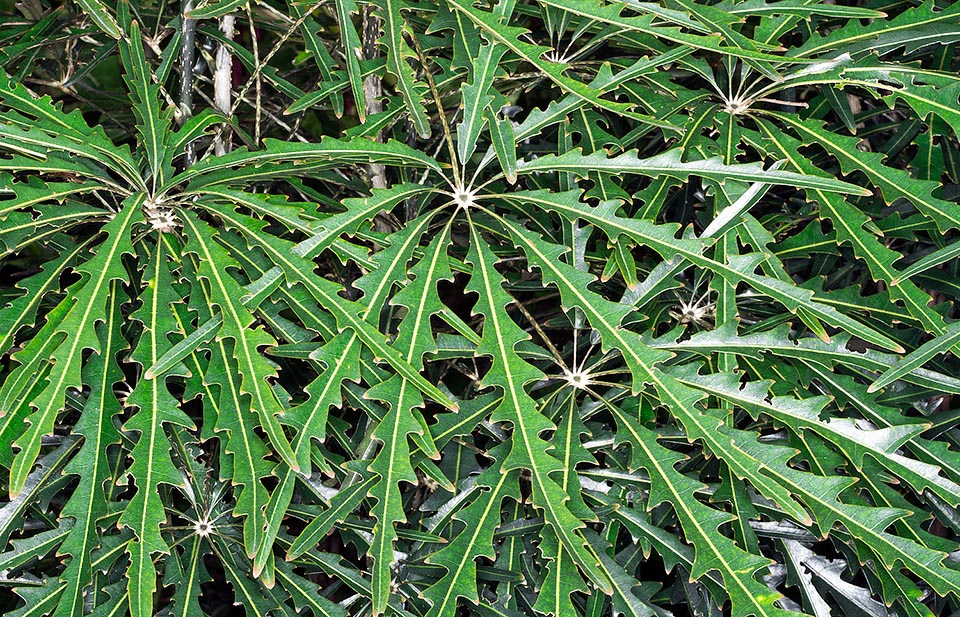Family : Araliaceae

Text © Pietro Puccio

English translation by Mario Beltramini
The species is native to a restricted area of south-western New Caledonia where it lives in the humid forests at low altitudes.
The generic name is the combination of the Greek adjective “πλήρης” (pléres) = full and of the substantive “ἀνήρ, ἀνδρός” (anér, andrós) = male, with reference to the numerous stamens present in the flowers of the species type; the specific name is the superlative of the Latin adjective “elegans, -antis” = elegant.
Common names: elegant schefflera, false aralia, finger aralia, spider aralia, threadleaf aralia (English); petit houx caledonien (French); Fingeraralie (German).
The Plerandra elegantissima (H.J.Veitch ex Mast.) Lowry, G.M.Plunkett & Frodin (2013) is a shrub or an unarmed evergreen tree, erect, initially not ramified, 8-15 m tall. The leaves, on a 10-14 cm long petiole in the young plants, 30-40 cm in the adult ones, are alternate, palmate-compound, formed by 7-12 leaflets almost linear with grossly and irregularly dentate margins, 13-25 cm long and 1-2 cm broad in the young plants or in the branches growing at the base of mature specimens, 20-30 cm long and 7-8 cm broad in the adult plants. The leaves are initially brown purple, then glossy dark green, coriaceous, with prominent greenish white central vein. Umbel compound terminal inflorescences with numerous small hermaphroditic pentamerous flowers of yellow-greenish colour. The fruits are sub-globose, of about 1 cm of diameter, of blackish colour containing usually 5-6 pale yellow seeds.
It usually reproduces by seed, previously kept in water for 2 days, placed superficially in sandy organic loam maintained humid at the temperature of 24-26 °C, wirth germination times, if fresh, of 3-5 weeks. It can also propagate, even if with difficulty, by cutting in spring-summer and by air layering in spring.

At high extinction risk in nature, Plerandra elegantissima is native to a narrow area of south-western New Caledonia. Slow growth and difficult cultivation © G. Mazza
In order to avoid the untimely fall of the leaves, which is the main problem met in its cultivation, we have to avoid the displacements, the sudden variations of temperature and the air currents. Also the too dry air can cause the same effect, are useful, therefore, frequent nebulizations with water, not calcareous in order to avoid unaesthetic spots on the leaves, at ambient temperature. The waterings must be regular, allowing the upper layer of the potting soil to dry up before giving water again, in order to maintain the potting soil constantly humid, but without stagnations, and the fertilizations, on a monthly basis, from spring to autumn, using a hydrosoluble balanced product with microelements at half the dosage suggested on the package.
The lymph contains slightly irritant substances that may cause reactions on the skin of the more sensitive persons.
Due to the reduction of the habitat caused by the excessive anthropization the species has been inserted into the the red list of the IUCN (International Union for Conservation of Nature) among the species at very high risk of extinction in the next future (“Endangered”).
Synonyms: Aralia elegantissima Veitch ex Mast. (1873); Schefflera faguetii Baill. (1878); Dizygotheca faguetii (Baill.) R. Vig. (1909); Dizygotheca elegantissima (Veitch ex Mast.) R. Vig. & Guillaumin (1912); Schefflera elegantissima (Veitch ex Mast.) Lowry & Frodin (1989).
→ To appreciate the biodiversity within the ARALIACEAE family please click here.
